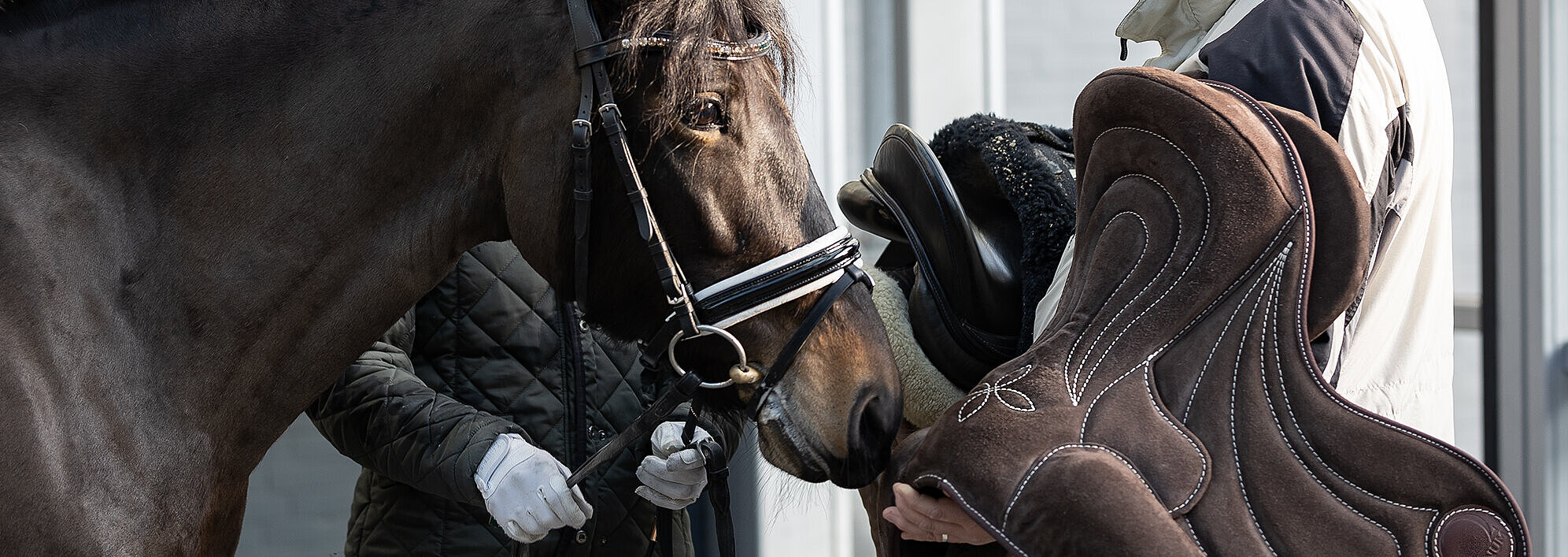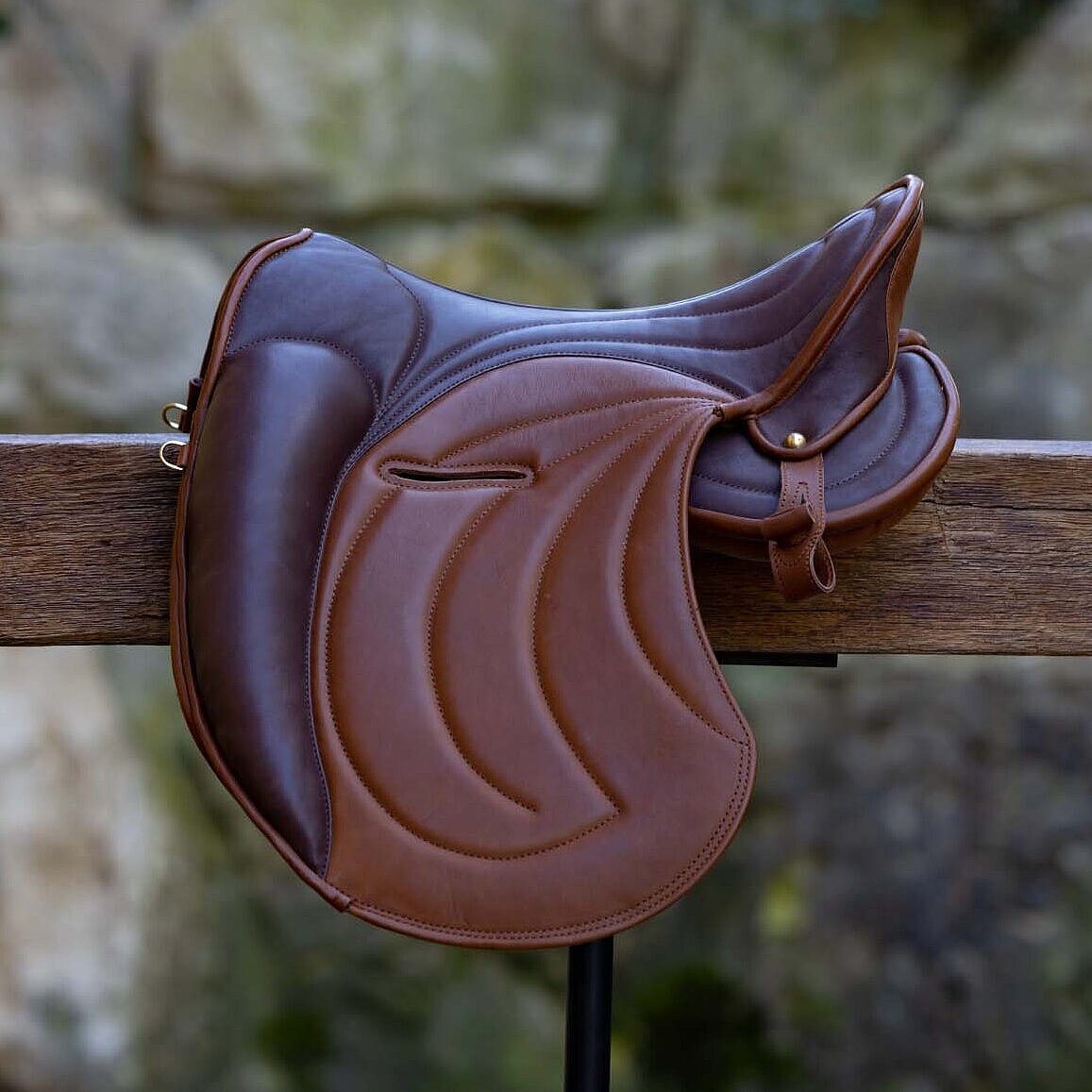Mini study saddle vs. PADDLE®
Study design & implementation by Claudia Dewes & Anja Müller-Martin. For conducting the study, the riding school Gestüt Akazienhof was granted a discount on the purchase of two paddles. No influence was exerted on the study design, implementation or publication of the results.

"We experience again and again that the subject of saddles is a great challenge for horse owners. First of all, a good, competent saddler has to be found, then a saddle has to be found that fits both the horse and the rider, the saddle has to be checked regularly, there are high costs overall, etc.
Of course, the riding school also faces the same challenge. We then became aware of the PADDLE® through social media. At first sight it seemed to be a good alternative to the saddle. Since the well-being of horse and rider is our top priority, we didn't want to just test the PADDLE® "by feel" - we wanted reliable proof.
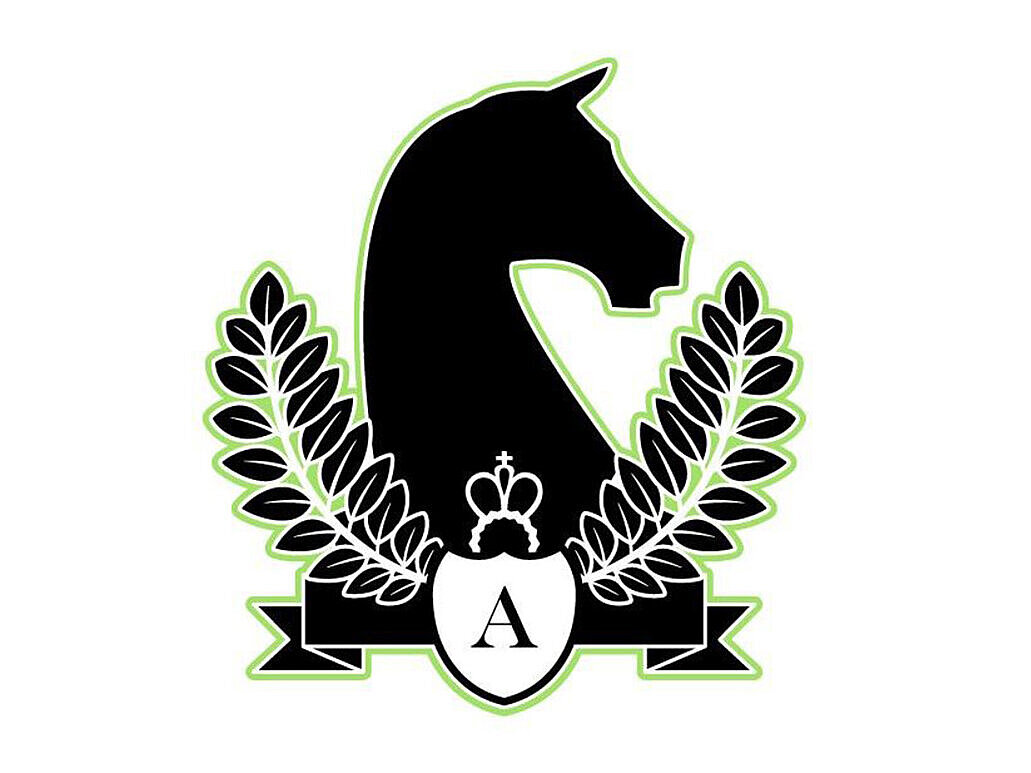
And so we decided to test the PADDLE® in a small mini study on some horse-rider pairs, in comparison to the saddle.
We were surprised ourselves by the test results - they speak for themselves!
Structure of the PADDLE® Study
4 horse-rider pairs are analysed. This test consisted of 3 parts:
- 1. ethogram (carried out by Claudia Dewes - specialist in expressive and learning behaviour) This particular ethogram (developed by Dr Sue Dyson) allows us to examine 24 expressive behaviours of the horse that may indicate stress and/or pain under the rider. Our intention was to examine the effects of the PADDLE® compared to conventional saddles. For this test study we selected some horse-rider pairs. For each pair, an ethogram was made with the current saddle (all saddles were checked by a qualified saddler) and an ethogram with the PADDLE®. The ethograms were then compared to identify any differences in behaviour.
- 2. assessment of the rider's seat (carried out by Anja Müller-Martin - Pferdewirtschaftsmeisterin with her own riding school and 30 years of professional experience). In addition, we analysed the rider's seat of the participating riders in the PADDLE® in comparison to the saddle. We assessed the position, contact and stability of the rider in the PADDLE® and in the conventional saddle.
- Finally, each testrider was asked to give a short feedback on the comparison.
Horse no. 1: Lavino
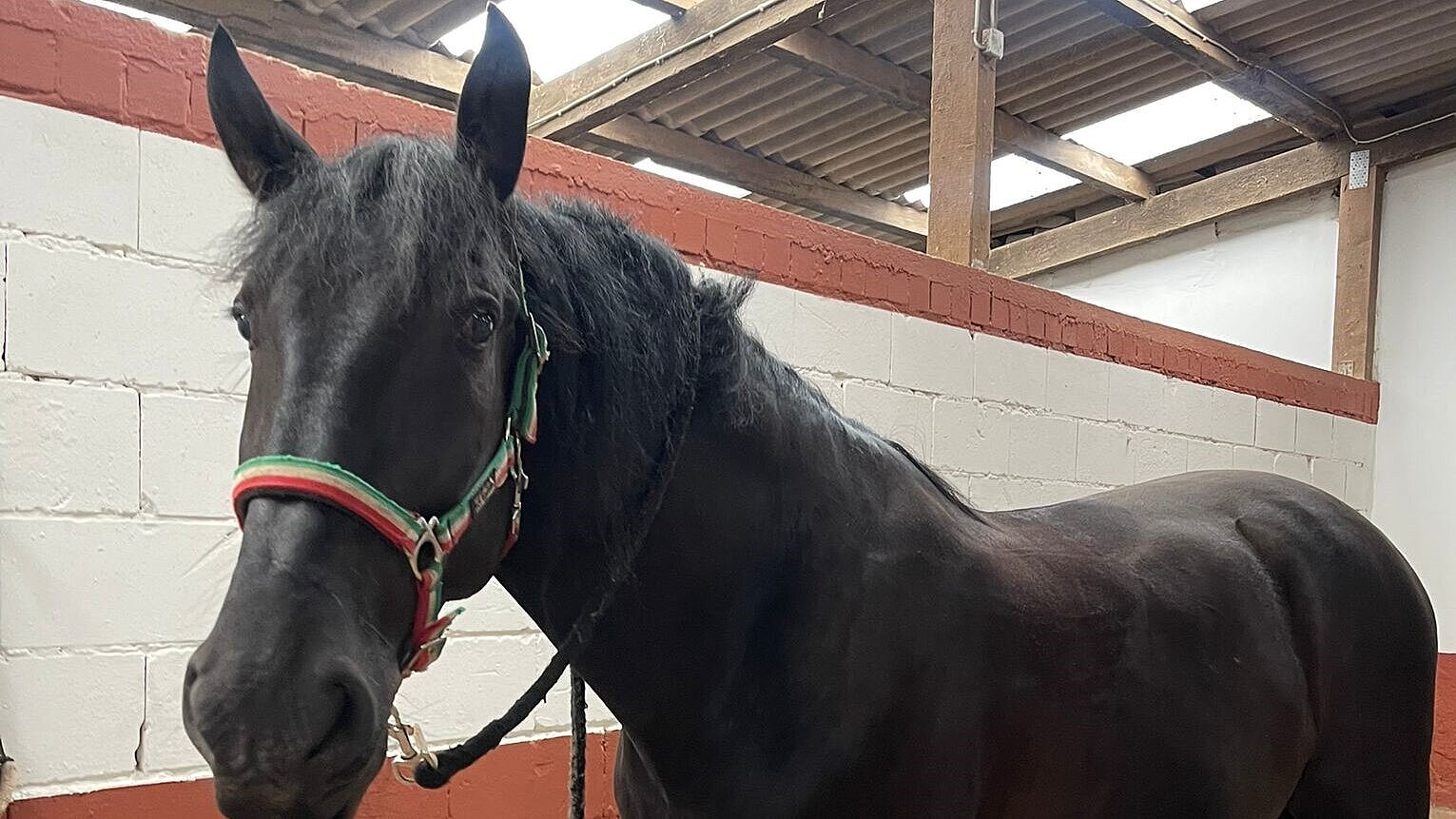
Short description of Lavino: Lavino is an 8 year old Murgese gelding. He is ridden as a leisure horse. His special features include a straight back with a short loin.
Ethogram Lavino
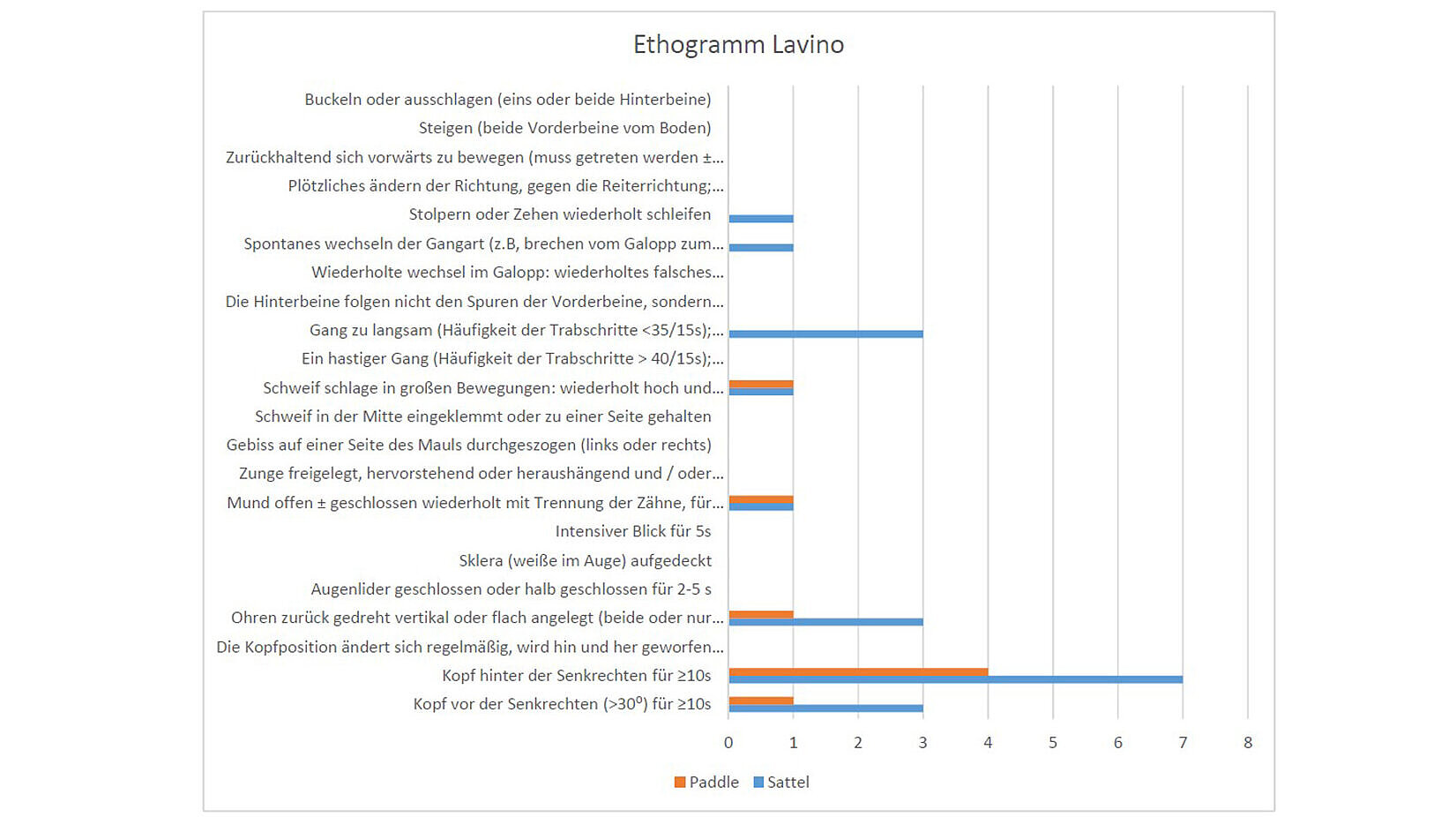
Conclusion: the ethogram clearly shows that Lavino felt more comfortable with the PADDLE® than with the saddle. He walked forward much more willingly and hid less behind the vertical.
| Rider seat assessment | SADDLE | PADDLE® |
| Position | Seat of the saddle is too big for the rider, rider sits too far back in the saddle. | The rider sits in the middle of the saddle because the seat is the right size. |
| Contact | Rider loses contact when sitting out, has to clamp to keep contact, saddle rocks at the trot and at the canter, clamps so much at the canter that the saddle slides forwards as a result of being pushed along. | Leg position improves, contact is much better when sitting out, in canter the rider sits properly with the PADDLE® and can maintain contact for a long time. |
| Stability | Thighs and lower legs come too far forward, tendency to sit in a chair, at times comes behind the movement in canter by permanently balancing and looking for stability in the torso area. Flexibility/pelvis: at walk and trot ok, when sitting out and cantering too much movement in the pelvis, therefore no longer in the movement of the horse, seat becomes unsteady and spongy. | The thighs stay still on the horse, more stability in the upper body, no more jamming in trot and canter, no more tendency to sit in a chair. Flexibility /Pelvis: Calm seat, rider swings in the movement, pelvis is upright. |
| Conclusion | The rider's seat improves significantly when riding with the PADDLE®. | |
Rider's report
"I like it very much because I have seen and felt such a clear change in Lavino. It's like he's really happy with it. As for me, I find the PADDLE® very comfortable. I think that if I used the PADDLE® more often and got some practice, I would get more and more comfortable with it (with the stirrups etc.). I think horse and rider have to get used to it after a few riding sessions, but I could imagine buying the paddle in the future. Great alternative to the saddle :) Kind regards"
Horse no. 2: Olli
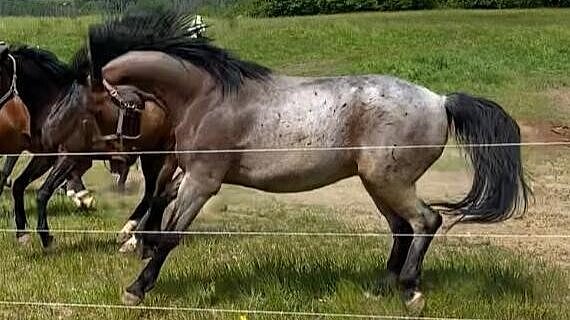
Short description of Olli is a German sport horse aged 9 years. He is ridden as a leisure horse. One of his special features is that his front hooves grow in different steep positions.
Ethogram Olli
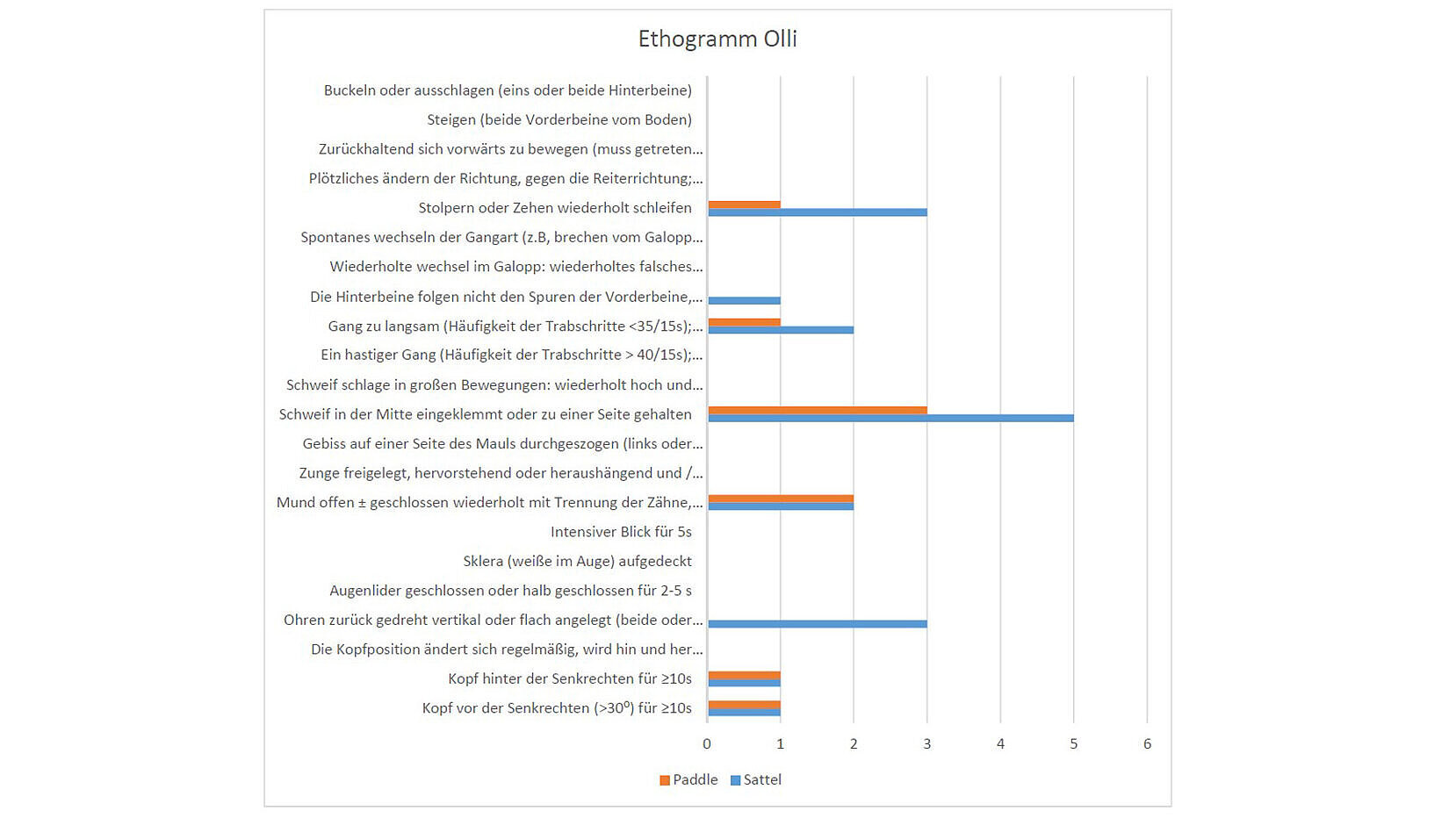
Conclusion: the ethogram shows that Olli is happier with the PADDLE®. In particular, the stumbling and tail flapping has decreased.
| Rider seat assessment | SADDLE | PADDLE® |
| Position | Knee a little far forward, at a walk the knee slips a little over the thigh, rider sits centrally, Saddle size ok for the rider. | Knee lower, sits too far back when trotting at first, better later, |
| Contact | Loses contact when sitting out and during cantering. | Heels no longer pulled up, almost no longer jams with the knees, bounces in the hock at trot, sits overall more on and in the movement of the horse, can hold contact at canter, leg position improved |
| Stability | Lower legs rock forward, when sitting out the rider jams the knee, canter: tilts forward when cantering , jams the lower legs and pulls up the heels, during the canter the rider comes into a sliding position Flexibility/pelvis: ok at a walk, somewhat inhibited when sitting out, too much movement in the pelvis at canter | Upper body better in body tension and uprightness, no more raised shoulders when sitting out and cantering Flexibility/pelvis: can swing better and more freely, sits more supple and in the movement, weight aids come through better, rider stays in the movement even in turns. |
| Conclusion | Clear improvements of the rider can be seen | |
Rider's report
"My opinion of the PADDLE® Test:
- I felt very comfortable in it from the first moment. Not only from the feeling of sitting, but also secure and not as wobbly as on a normal pad.
- I had the feeling that my horse moved better (more freely, fluffier).
- When riding myself, I had the feeling that the PADDLE® was slightly bouncy. It seemed to me as if you were being automatically thrown up again and again, like on a trampoline. This made light trotting very easy for me.
- Cantering is the same as trotting: It feels as if you fall into a cushion that throws you right back up again. Very pleasant! It also meant I didn't get my legs stuck like that.
- No back pain after the ride. Unfortunately that is almost always the case especially after sitting out and cantering with the saddle."
Horse no. 3: Florek
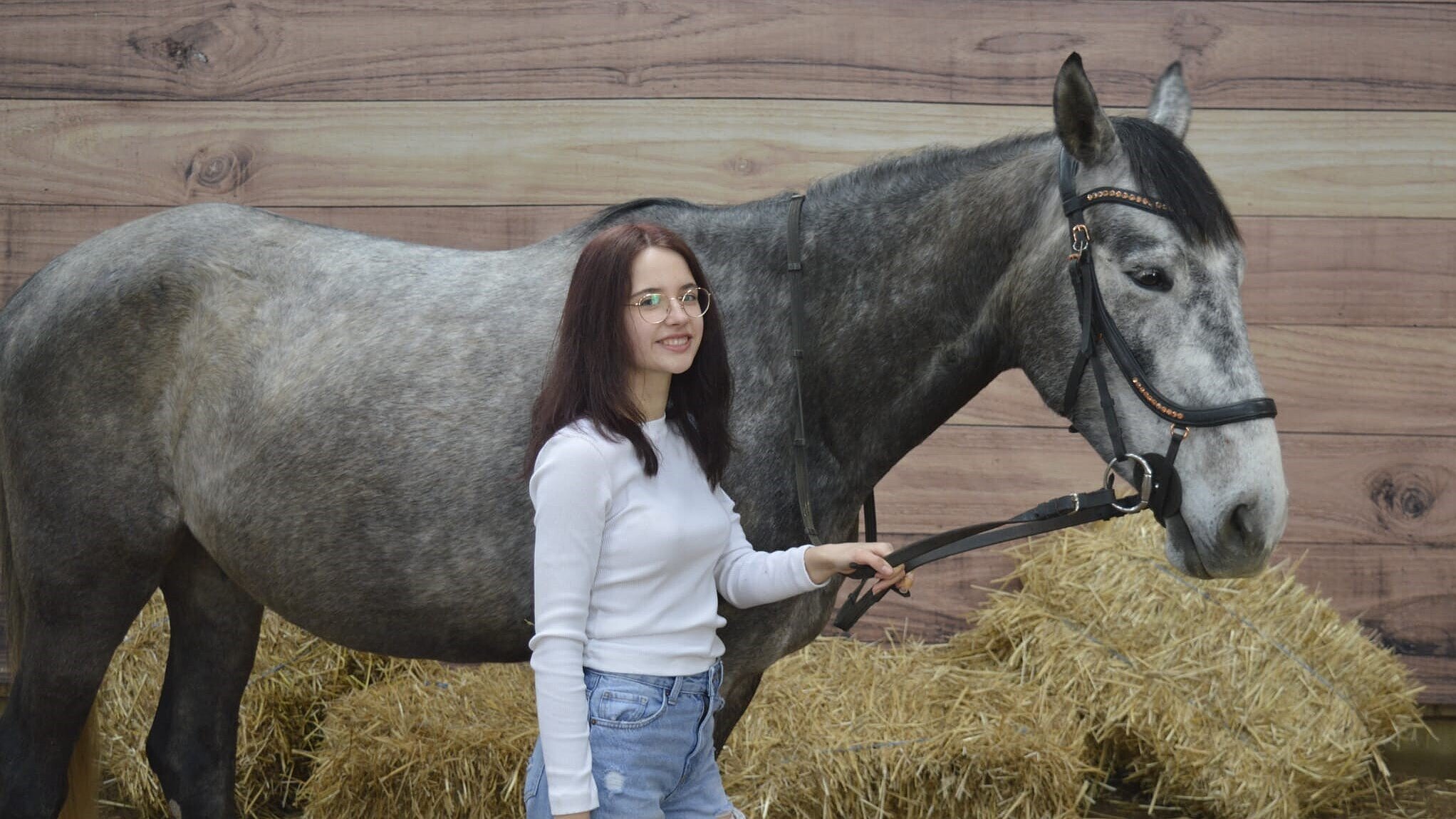
Short description of Florek: Florek is a Polish small horse, even though he is 1.66m tall. He is 5 years old and is ridden as a leisure horse. His special features include a straight back, steep hooves & a short fetlock.
Ethogram Florek
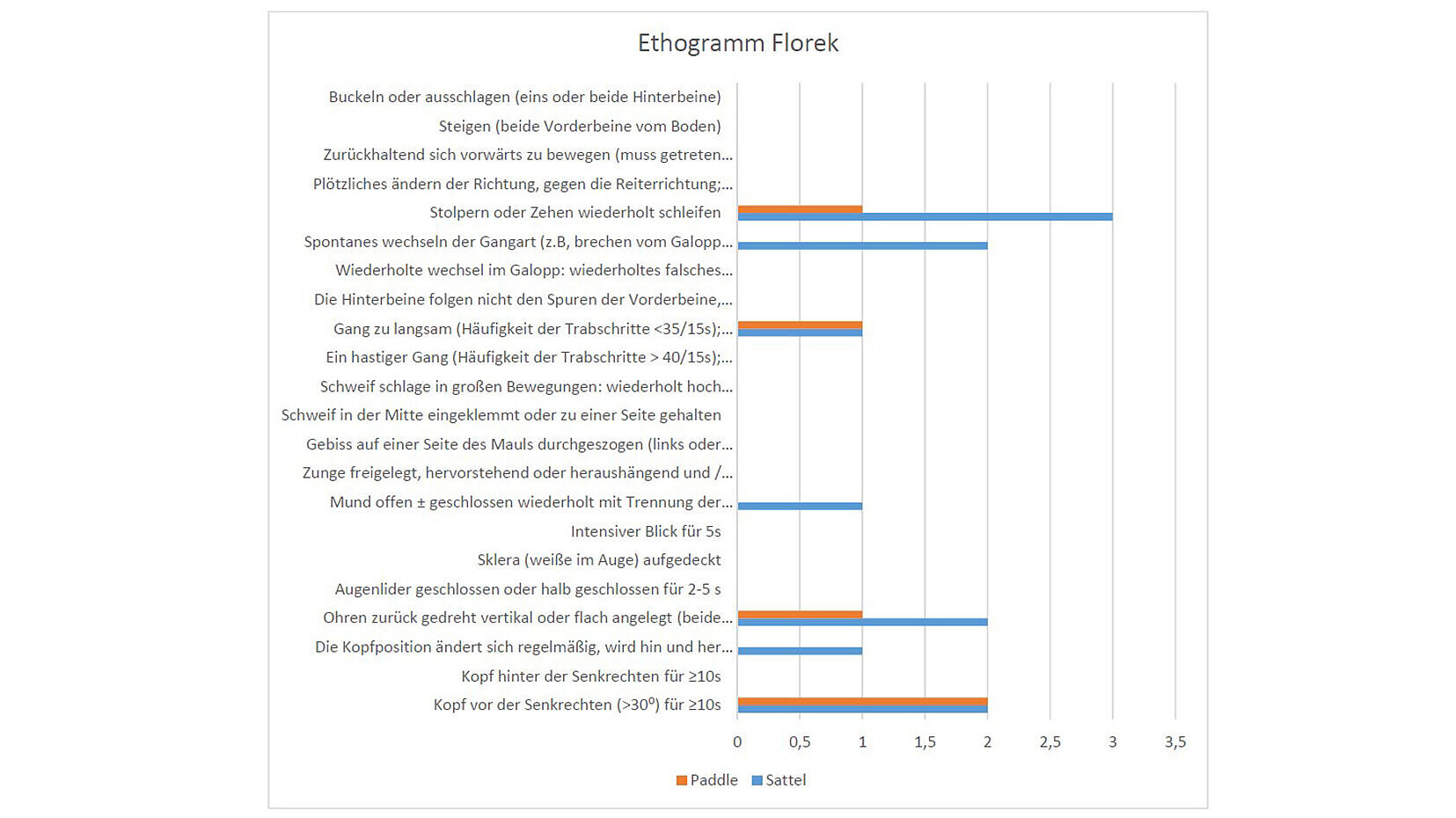
Conclusion: The ethogram also shows that Florek has improved a lot under the PADDLE®. The stumbling has decreased and he no longer showed sudden changes of gait.
| Rider seat assessment | SADDLE | PADDLE® |
| Position | At a walk everything is good, at a trot the saddle begins to sway a little, thighs lose position especially the outer thigh | Sits centrally in walk, leg position improves considerably, especially the outer leg keeps position |
| Contact | when sitting out, loses contact and jams the knee | When sitting out it is easier for the rider to keep contact, she doesn't jam her knee as much anymore |
| Stability | Rider sits well, comes a little far back in the saddle when sitting down in light trotting Mobility/pelvis: a little tight in the pelvic area when sitting out. | Sits in the middle when trotting Flexibility/pelvis: swings more, sits more in time with the horse's movement. |
| Conclusion | In the PADDLE® the rider's seat improved. The rider did not feel comfortable in the PADDLE® in this case. Riding in the PADDLE® causes her back pain. | |
Rider's report
"Very spongy feeling in the PADDLE®, do notice that the Florek is running better, but I can't manage the PADDLE®. My back is starting to hurt."
Horse no. 4: Skadi
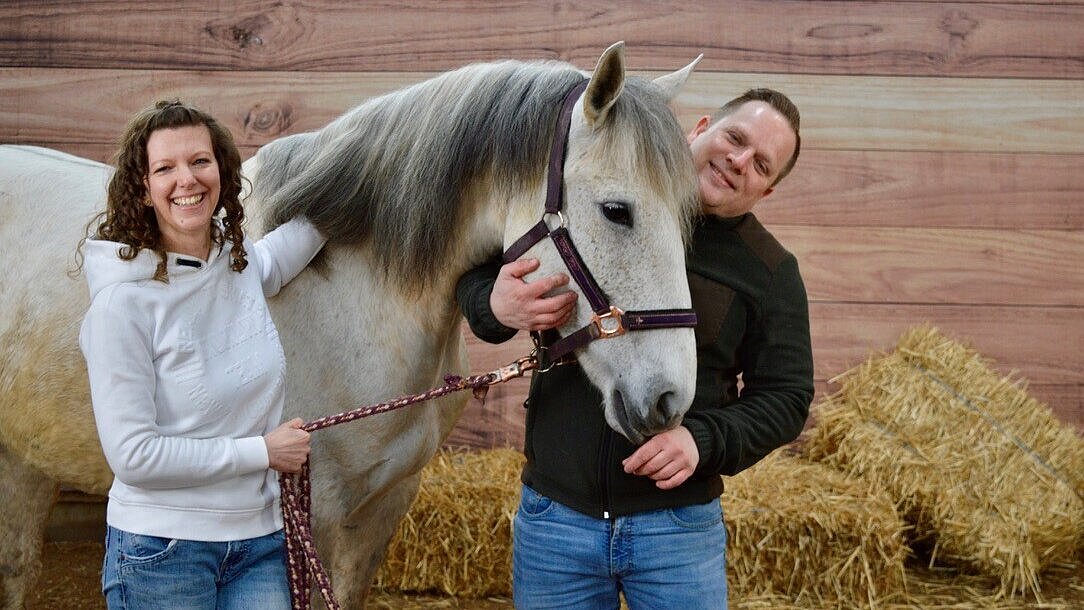
Short description of Skadi: Skadi is a 6 year old Portuguese sport horse. She is ridden as a leisure horse and is trained completely via positive reinforcement. Skadi brings a special feature with her: Headshaker.
Ethogram Skadi
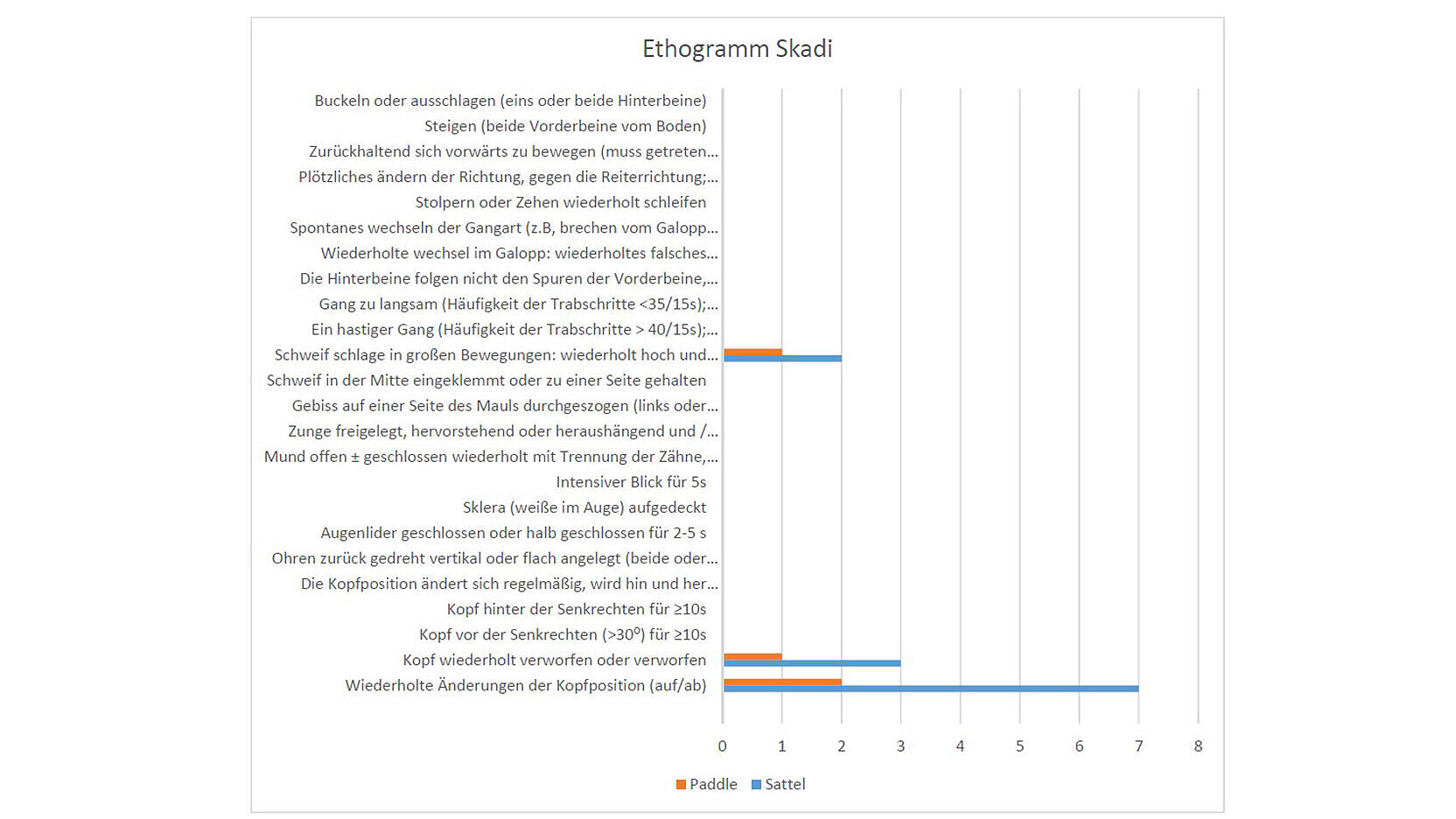
Conclusion: The ethogram clearly shows the improvement of Skadi's head position. Skadi is a headshaker. So far she shows this under every saddle, only when riding with a riding pad it got better. The longer she was ridden with the PADDLE®, the more her head stayed still. Since then she has only been ridden with the PADDLE® and is currently shake-free.
| Rider seat assessment | SADDLE | PADDLE® |
| Position | Rider comes into the chair seat several times, saddle flaps of the saddle are too long for the rider's thighs | Rider sits centrally, not in chair seat |
| Contact | Rider loses contact when sitting out, has to clamp to maintain contact. | Leg position improves, contact with the horse much better when sitting out. |
| Stability | Thighs and lower legs come too far forward, several times to the chair seat Mobility/pelvis: altogether too much movement in the pelvis, therefore no longer in the movement of the horse, seat becomes unsteady again and again | The thighs remain still on the horse, more stability in the upper part of the body, no more chair seat Flexibility/pelvis: calm seat, rider swings in the movement, pelvis is upright. |
| Conclusion | The rider's seat improves significantly when riding with the PADDLE®. | |
Rider's report
"I haven't felt this comfortable riding in a long time. Because of my short height, most saddle flaps are too long. I was even more convinced by Skadi's reaction. No more shaking - and now also in the long-term test."
